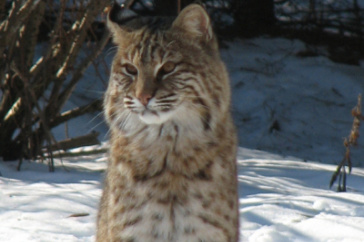The University of New Hampshire is a flagship research university that inspires innovation and transforms lives in our state, nation and world. More than 16,000 students from all 50 states and 71 countries engage with an award-winning faculty in top ranked programs in business, engineering, law, health and human services, liberal arts and the sciences across more than 200 programs of study. UNH’s research portfolio includes partnerships with NASA, NOAA, NSF and NIH, receiving more than $100 million in competitive external funding every year to further explore and define the frontiers of land, sea and space.
New UNH Bobcat Research Aims to Understand Why Wildcats Are Rebounding

A bobcat in winter. Scientists theorize bobcats have rebounded, in part, because they have shifted their diet to different prey, such as turkeys and squirrels that hang out beneath bird feeders during the winter.
Credit: UNH
DURHAM, N.H. – New Hampshire’s bobcats are rebounding despite increased development and human activities in their natural habitats and decreases in the availability of their prey. A new research project funded in part by the NH Agricultural Experiment Station at the University of New Hampshire aims to understand why.
“Bobcats are now functioning as apex predators, and as a result, their success may be an important indicator of overall ecosystem health,” said Marian Litvaitis, professor of natural resources and the environment. “Recent population increases suggest that bobcats are adapting to a changing environment. Identifying the pathways of this success may provide insight into understanding how ecosystems can remain relatively intact as human population continue to expand.” She and doctoral student Rory Carroll are leading the study.
New Hampshire’s bobcat population has rebounded since the wildcat was protected from hunting in 1989. UNH researchers estimate there are as many as 1,400 bobcats in the state.
Specifically, researchers want to examine how changes in land use such as increased development and human activities have affected bobcats in northern New England. Researchers also want to understand why current bobcat populations are making a comeback despite a dramatic decrease in their traditional prey such as rabbits and hares.
Scientists theorize bobcats have rebounded, in part, because they have shifted their diet to different prey, such as turkeys and squirrels that hang out beneath bird feeders during the winter. To test their hypothesis, they will compare the stable isotope signatures – different forms of chemical elements such as nitrogen and carbon -- in possible prey animals with those in bobcat hair. The idea behind the analysis is that isotope signatures in a top predator are a reflection of foods consumed at different ecological levels.
They also want to understand if bobcats that live in more developed areas are subjected to higher levels of stress. To do this, scientists will compare levels of a stress hormone called cortisol in hairs from individuals living in developed areas with those from individuals in more rural areas.
“Increased stress has been associated with a decreased immune response and decreased reproductive success in animal populations. Ultimately this may allow for projections about the general health of the bobcat population,” Litvaitis said.
This research will contribute to a better understanding of bobcat distributions, especially relative to human landscape use. This allows for the development of effective management strategies, and ultimately, may be useful for maintaining biodiversity in human-dominated landscapes.
To learn more about UNH’s bobcat research, visit tinyurl.com/NHbobcats.
This material is based upon work supported by the NH Agricultural Experiment Station, through joint funding of the National Institute of Food and Agriculture, U.S. Department of Agriculture, under award number 1009906, and the state of New Hampshire. It is also supported by an NSF Graduate Research Fellowship to Rory Carroll. This project builds on data collected during two previous studies on New Hampshire bobcats funded by New Hampshire Fish & Game and the NH Agricultural Experiment Station.
Founded in 1887, the NH Agricultural Experiment Station at the UNH College of Life Sciences and Agriculture is UNH’s original research center and an elemental component of New Hampshire's land-grant university heritage and mission.
EDITORS AND REPORTERS: Researcher Marian Litvaitis can be reached at marian.litvaitis@unh.edu.
Latest News
-
October 30, 2024
-
October 10, 2024
-
October 8, 2024
-
October 3, 2024
-
October 1, 2024
















































